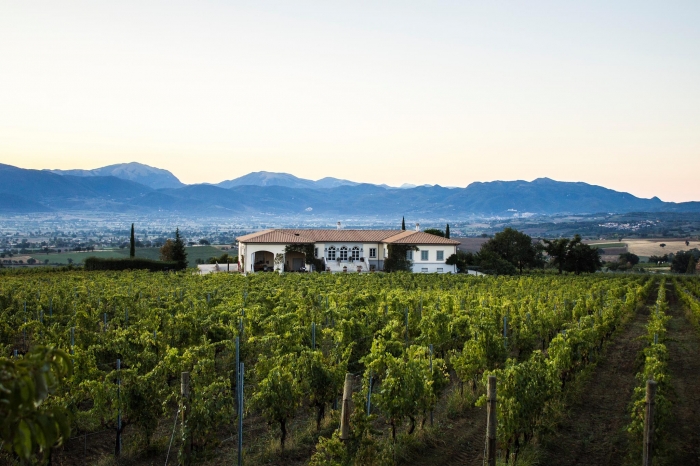Lungarotti: A Century-Old Legacy of Umbrian Winemaking Excellence
How Giorgio Lungarotti Transformed Umbrian Wine
2024-07-10

The Umbrian landscape is characterized by rolling hills, medieval villages, and verdant vineyards, where the legacy of Lungarotti stands as a testament to Italian wine excellence. This narrative begins with Giorgio Lungarotti, a pioneer in modern enology who transformed his family farm into a renowned winery in Torgiano, a village nestled between Perugia and Assisi. Today, this legacy is sustained by three generations of the Lungarotti family, who blend innovation with tradition to maintain the distinctive quality of their wines while championing sustainable production practices.
For over a decade, Wine Spectator has recognized Lungarotti as one of the premier wineries, consistently inviting them to the prestigious OperaWine event. This acknowledgment underscores Lungarotti's commitment not only to producing exceptional wines but also to fostering a rich cultural and environmental ethos around wine. Their philosophy integrates quality production with outstanding hospitality, the preservation of historical and cultural heritage, biodiversity protection, and authentic experiences in nature, encapsulating what they call the Lungarotti Experience.
Lungarotti's story is one of deep-rooted love for the land, spanning centuries. The family's journey in winemaking and olive oil production began in the Mid-Tiber River valley over two centuries ago. By the early 1900s, Giorgio Lungarotti's father and uncle were already known for the quality of their wines, including a famed Vin Santo, albeit their reputation was confined to the local level.
Giorgio Lungarotti, with a degree in Agriculture obtained in 1936, brought a visionary approach to viticulture. In 1949, he showcased the need for modern viticulture at the Perugia Grape Fair, marking the beginning of a transformation in Umbrian winemaking. He embraced three principles: quality enhancement, specialized viticulture, and the abolition of share-cropping, leading to the establishment of a winery that produced the first bottled wines, "Rubesco" and "Torre di Giano," from the 1962 harvest. These wines earned one of Italy's first DOC appellations in 1968, setting a high standard for Umbrian wines.
Since Giorgio's passing in 1999, his daughters Chiara Lungarotti and Teresa Severini have led the company, bringing their expertise and innovative spirit to the fore. Chiara, with a degree in Agriculture and specialization in Viticulture, believes in the balance of innovation and tradition. Her profound connection to the land is palpable, and she passionately advocates for the cultural significance of wine and olive oil in Umbrian and Italian heritage.
Teresa, one of Italy's first female enologists, directs Marketing and Communication with a focus on aligning the product with the company's identity and territory. She emphasizes educating young people about wine, striving to make them informed wine lovers of the future. Her dynamic approach extends to her involvement in "Le Donne del Vino," an association promoting the role of women in the wine sector.
Maria Grazia, Chiara and Teresa's mother, contributes significantly through the non-profit Lungarotti Foundation, which she directs. With a background in Literature and History of Art, she has dedicated over 40 years to promoting the cultural heritage of wine and olive oil, founding the Wine Museum of Torgiano (MUVIT) in 1974 and the Olive and Oil Museum (MOO) in 2000.
Lungarotti's dedication to sustainability is evident in their practices. Their 250 hectares of vineyards in Torgiano and Montefalco are managed with a focus on biodiversity and environmental responsibility. The Torgiano estate, VIVA certified since 2018, employs sustainable vineyard techniques, while the Montefalco estate has been organically cultivated since 2010 and certified organic since 2014.
In Torgiano, the estate covers 230 hectares and produces a diverse range of wines, including reds, whites, rosés, and sparkling wines. The winery also boasts a significant olive grove, producing organic extra virgin olive oil. The Montefalco estate, acquired in 2000, focuses on producing organic wines and features a modern, underground winery designed to be environmentally friendly.
The Lungarotti Experience offers a multitude of ways to engage with the winery's heritage. Visitors can tour the vineyards and wineries in Torgiano and Montefalco, witnessing the winemaking process and tasting the wines. These tours provide an immersive experience, from the vineyards to the aging cellars, highlighting the dedication and craftsmanship behind each bottle.
In addition to winery tours, the Lungarotti Foundation's museums, MUVIT and MOO, provide a cultural journey through the history of wine and olive oil. MUVIT, one of the world's most comprehensive wine museums, displays over three thousand artifacts, while MOO explores the history and significance of olive oil.
Art and culture are integral to Lungarotti's identity. The family has a long-standing tradition of intertwining wine with art, evident in their collaboration with contemporary artists. One notable piece is "Triple Twist" by Beverly Pepper, a sculpture symbolizing the vine and life, installed at the Torgiano winery.
Lungarotti's commitment to hospitality is showcased in their agritourism offerings. Poggio alle Vigne, a renovated 17th-century homestead, and Il Poggiolo, a romantic rural annex, provide serene retreats surrounded by vineyards and olive groves. Guests can also enjoy culinary experiences at Enoteca della Cantina and Osteria del Museo, where local cuisine is paired with Lungarotti wines.
Lungarotti represents a blend of tradition, innovation, and sustainability, rooted deeply in the rich cultural and natural heritage of Umbria. Through their dedication to quality, environmental responsibility, and cultural promotion, they continue to tell the story of Umbria and Italy to the world, crafting a legacy that transcends generations.
Founded in 2007, Vinetur® is a registered trademark of VGSC S.L. with a long history in the wine industry.
VGSC, S.L. with VAT number B70255591 is a spanish company legally registered in the Commercial Register of the city of Santiago de Compostela, with registration number: Bulletin 181, Reference 356049 in Volume 13, Page 107, Section 6, Sheet 45028, Entry 2.
Email: [email protected]
Headquarters and offices located in Vilagarcia de Arousa, Spain.